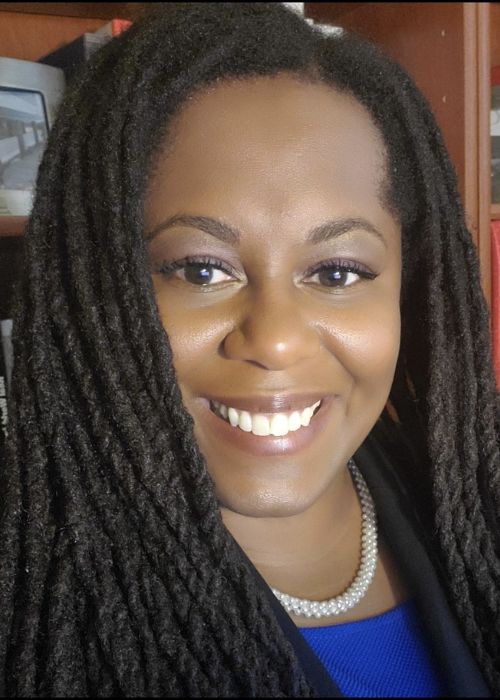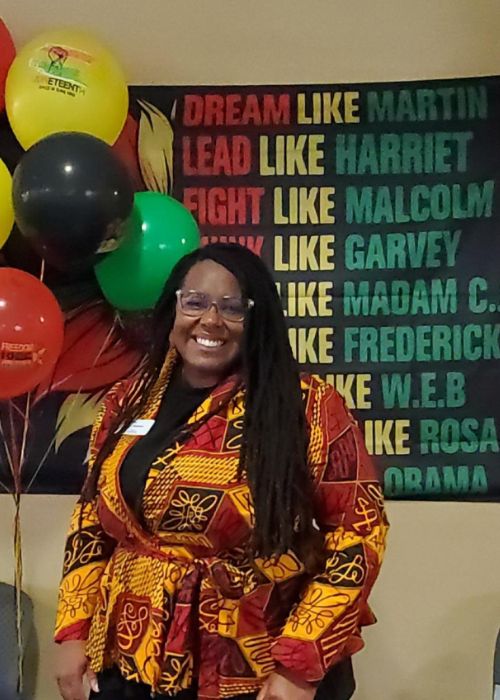Capital gains: Alumna Alicia Stephens maximizes employee and organizational performance by banking on background in instructional design

Pregnant with her first child, Pontiac, Michigan, native Alicia Stephens waddled into the Wayne State University College of Education, wondering if she could balance graduate studies with a full-time job and motherhood.
“There was a little girl playing in the office, and the advisor explained that she had to bring her to work,” she said. “Knowing I might be in the same situation soon, I told her it was not a problem. I shared my concerns with her, and she encouraged me. She said, ‘If I can do it, you can, too.’ That was the message I needed to hear.”
Six months after Stephens and her husband welcomed their new baby into the world, she began taking courses. Although she was six years into her banking career, she did not want to study business like most of her peers.
“I wanted to connect the dots between performance and positive business outcomes,” she said. “After working in a variety of positions in financial services, I discovered I was most engaged and did my best work in learning and development, so I chose instructional technology with a concentration in performance improvement to explore ways to empower my colleagues to engage in their best performance.”
During her almost 23-year career, Stephens has worked at two financial services companies. She has served as branch manager and commercial credit analyst; sold traditional banking products, investments and insurance; and managed units such as communications, training, and client relations. Now senior vice president and director of Corporate Quality at Comerica Bank, she oversees a team that represents the Office of the Chairman and handles all complaints, including those received directly from customers and agencies such as the Better Business Bureau, Consumer Financial Protection Bureau, Federal Reserve and Office of the Comptroller of the Currency. She said studying instructional technology — now called learning design and technology — prepared her for the detailed analysis and documented action required in her role.
“We review a complaint, determine the root cause, then create interventions to mitigate the risk of it recurring,” she said. “It's the same thing we do in instructional technology. We review our environment and our target performance — where we want to be as opposed to where we are — then look for interventions to close the gap. That very holistic, systematic and cyclical way of looking at business and people in environments has served me well.”
Stephens said learning design and technology — and its focus on helping people reskill and upskill — has become more important since the pandemic.
“Managing and leading from a distance will continue to be a hot topic because more people work remotely,” she said. “We need to make sure leaders can effectively manage all team members — even those who may be on the other side of the world. How do we build that skill as well as competencies in diversity, equity and inclusion — because now we're going to have more ethnic, racial, geographic and other types of diversity — in the virtual space? And how do we build those relationships so we can positively impact business outcomes?”
Stephens believes companies that view remote work as an opportunity instead of a challenge and are strategic about planning in-person activities will attract the best talent, build strong relationships and boost retention.

“Willingness to assemble teams over a larger geographic space gives us access to a bigger pool of talent, so organizations must recognize and leverage the advantages of remote work,” she said. “Companies that are intentional about designing collaborative workspaces and creating informal opportunities to communicate and build community when employees are face-to-face will be most attractive to prospective talent. That type of leadership starts at the top. I am fortunate to work for a company that is forward thinking in terms of virtual work and collaboration and intentional about investing in the training necessary to ensure its leaders and managers develop these skills.”
Stephens said convenience, cost and connections were among the reasons she chose to attend Wayne State.
“Wayne State is a strong research institution and the graduate school of choice for busy professionals in Southeast Michigan who want a top-notch education at a reasonable price,” she said. “Another bonus was having access to the strong educational, business and community networks Wayne State has always been part of.”
Stephens most enjoyed the opportunities to build knowledge and skills by addressing real-world challenges. This aligns with Wayne State’s College to Career initiative, which seeks to provide all students with experiential learning opportunities that allow them to encounter the world, gain deeper insights and new perspectives, and prepare for prosperous careers.
“Faculty emphasize practical application of knowledge, so you can immediately apply what you learn,” she said. “Our assignments were not just about theory. We developed skills in analysis and learning design by creating and evaluating programs for actual companies and community organizations.”
Stephens fondly recalled that long-time faculty member James Moseley helped her become a skilled practitioner and a published author.
“He asked me to contribute a chapter to the new textbook he was writing,” she said. “I was hesitant because I had never written anything for a book or textbook before, but he said, ‘I know this is something you can do.’ He saw something in me I did not see and encouraged me to pursue an opportunity I hadn’t considered. It was a wonderful experience and something I'm still proud of and will never forget.”
Although instructional design is a growing field and offers flexibility, work-life balance, and high salaries, the percentage of Black instructional designers has hovered around 10% for the last 14 years. Latinos represent 17% of designers, and Asians comprise about 5%. Stephens said educating others about the profession and engaging instructional designers of color in efforts to expose young people of color to opportunities could help increase those percentages.
“My classmates worked in the auto industry, education, finance and banking, medicine, and many other fields,” she said. “All industries need instructional design because it is about people and performance. Promoting the broad applicability of the field is critical to increasing diversity in the profession. As a woman of color and a graduate of Wayne State’s program, I share my story to encourage young people to consider careers in instructional design. As practitioners, we need to show them the potential and possibilities.”
by Tracy A. Boyce